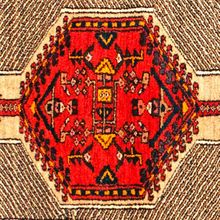Sarab Rug
| Sarab Rug | |
|---|---|
 Design of Sarab Rug (Rugman) | |
| General information | |
| Name | Sarab Rug |
| Original name | قالی سراب |
| Alternative name(s) | Sarab Carpet |
| Origin | |
| Category | Village |
| Technical information | |
| Common designs | Herati, Medallion, Lattice |
| Common colors | Camel, Blue, Red, Brown, Navy Blue, Bege |
| Dyeing method | Natural, Synthetic |
| Pile material | Wool |
| Foundation material | Wool, Cotton |
| Knot type | Symmetrical (Turkish) |
Sarab rugs originate from Sarab, located in northwestern Iran in Azerbaijan, is famous for good quality rug runners from 10’ to 20’ long and 3’ wide, in addition to doormat size rugs. Prior to 1813 Sarab and the whole greater Mount Savalan region including the rug producing areas of Heriz, Ahar, and Gorevan was known as the Khanate (an old fashion term for an administrative district or state) of Sarab. Although the rug runners can be very long lengths, the widths are limited to just under 4’ due to the fact that the old fashioned looms that are used are smaller in size in order to facilitate transportation. Sarab rugs are woven using both Persian and Turkish knots. Their quality is higher than the average rug runners and knot counts vary from 80 to 100 KPSI (knots per square inch).
History
Sarab, also spelled Serab, is a town located in the East Azerbaijan Province of northwestern Persia. Sarab rugs are known in the antique market from the mid-nineteenth century. The cold climate of Sarab forced weavers indoors, where space limitations required that they produce their rugs on narrow looms more practical for weaving runners and other tribal items. Sarab consumers originally placed several runners together to cover room floors in their homes.
Sarab rug designs are geometric, with medallions in the shape of diamonds, pendants, and hexagons repeated along the length of the runner. Stylized Hook motifs sometimes edge the medallions, which bear influences from Asia Minor tribal weavings. Some field designs display half- and quarter-medallions along the inner borders and in the corners. The medallions feature flower heads, leaves, and vines or a Herati (fish) pattern. A variety of tribal ornaments are also woven between the medallions throughout the field. Some of the older Sarab runners feature a special two-tone color effect in camel and ivory, with broken leaves, vines, and flower heads in the background. The impact of the light colors is engaging and unique among all tribal weavings.
The borders in Sarab runners are narrow and consist of one, two, or three guard borders. The border designs have flower heads, leaves, vines, animals, and other tribal design elements. Reciprocal trefoil designs were made for the main or guard borders. Some Sarab runners have a beautiful, plain, camel-colored outer border with one, two, or several motifs of flower heads, shrubs, animals, birds, or human figures woven in a primitive style.
After World War II, a Tabriz master weaver named Mashayekhi established a workshop in Sarab. Under his supervision, Sarab weavers made fine-quality Tabriz-style carpets with herati designs. They were profitable and in demand for domestic and Western markets. These Sarab woven carpets were signed "Mashayekhi."
Sarab rugs have a wool or cotton foundation, or a mixture of both. The Turkish (symmetric) knot is universally used. The runners are known for their camel hair or camel-colored wool pile. This color was unique and in high demand in the Western market. Sarab runner background colors are mostly in camel tones, with a small percentage having reds or dark blue. Additionally, browns, greens, ivory, beige, peach, and gold appear in the border, medallion, and design elements.
The formats range from small tribal items to runners approximately seventeen feet in length. Very rarely were gallery sizes and scatter rugs made in Sarab. Mashayekhi Sarab Tabriz-style carpets were made in dimensions of approximately nine feet by six feet to living room sizes. Sarab weavings are medium to fine in grade quality.
It should be noted that the coloration and designs of Sarab weavings are present in the weavings produced in the Mehraban of Hamadan. Both the Mehraban and Sarab people use a Turkic dialect, and it is believed that these two tribes may have been joined at a point in the past but kept their shared weaving tradition intact once separated.[1]
See also
References
- ↑ Moheban, 2015, 492-494
Bibliography
- Abraham Levi Moheban. 2015. The Encyclopedia of Antique Carpets: Twenty-Five Centuries of Weaving. NewYork: Princeton Architectural Press.